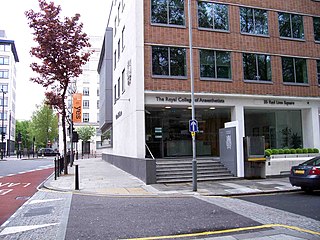Related Research Articles

General anaesthesia (UK) or general anesthesia (US) is a method of medically inducing loss of consciousness that renders a patient unarousable even with painful stimuli. This effect is achieved by administering either intravenous or inhalational general anaesthetic medications, which often act in combination with an analgesic and neuromuscular blocking agent. Spontaneous ventilation is often inadequate during the procedure and intervention is often necessary to protect the airway. General anaesthesia is generally performed in an operating theater to allow surgical procedures that would otherwise be intolerably painful for a patient, or in an intensive care unit or emergency department to facilitate endotracheal intubation and mechanical ventilation in critically ill patients. Depending on the procedure, general anaesthesia may be optional or required. Regardless of whether a patient may prefer to be unconscious or not, certain pain stimuli could result in involuntary responses from the patient that may make an operation extremely difficult. Thus, for many procedures, general anaesthesia is required from a practical perspective.

The Association of Anaesthetists, in full the Association of Anaesthetists of Great Britain and Ireland (AAGBI), is a professional association for anaesthetists in the United Kingdom and Ireland.
Roe v Minister of Health [1954] 2 All ER 131 is an English tort law decision of the Court of Appeal of England and Wales which has had a significant influence on the common law throughout the common law world.
Thomas Cecil Gray CBE KCSG was a pioneering English anaesthetist.

The Royal College of Anaesthetists (RCoA) is the professional body responsible for the specialty of anaesthesia throughout the United Kingdom. It sets standards in anaesthesia, critical care, pain management, and for the training of anaesthetists, physicians' assistants (anaesthesia), and practising critical care physicians. It also holds examinations for anaesthetists in training, and informs and educates the public about anaesthesia. Its headquarters are in Churchill House, London.
Alfaxolone/alfadolone is a short acting intravenous anesthetic agent. It was withdrawn from the market due to severe drug reactions. It is composed of a 3:1 mixture of alfaxalone and alfadolone, two neurosteroids.

Methoxyflurane, sold under the brand name Penthrox among others, is an inhaled medication primarily used to reduce pain following trauma. It may also be used for short episodes of pain as a result of medical procedures. Onset of pain relief is rapid and of a short duration. Use is only recommended with direct medical supervision.
Andrew Gerald Doughty MRCS LRCP FRCA FRCOG was an English anaesthetist.

Minaxolone (CCI-12923) is a neuroactive steroid which was developed as a general anesthetic but was withdrawn before registration due to toxicity seen with long-term administration in rats, and hence was never marketed. It is a positive allosteric modulator of the GABAA receptor, as well as, less potently, a positive allosteric modulator of the glycine receptor.

The British Journal of Anaesthesia is a monthly peer-reviewed medical journal published by Elsevier on behalf of the Royal College of Anaesthetists, the College of Anaesthesiologists of Ireland, and the Hong Kong College of Anaesthesiologists, for all of which it serves as their official journal.
ACE mixture is an historical anaesthetic agent for general anaesthesia. It was first suggested by George Harley and first used in England around 1860. In 1864 it was recommended for use by the Royal Medical and Surgical Society's Chloroform Committee. It was rarely used after the 19th century, except in Germany, where it was used for slightly longer.
BJA Education, formerly known as Continuing Education in Anaesthesia, Critical Care & Pain and BJA CEPD Reviews is a bimonthly peer-reviewed medical journal. Originally published by Oxford University Press, it is now published by Elsevier since 2018. It is a joint undertaking of the British Journal of Anaesthesia and the Royal College of Anaesthetists in collaboration with the Faculty of Pain Medicine, the College of Anaesthesiologists of Ireland, the Hong Kong College of Anaesthesiologists and the Faculty of Intensive Care Medicine. It publishes materials to support the continuing medical education and professional development of specialists in anaesthesia, critical care medicine, and pain management. The structured articles are commissioned and cover core knowledge, current controversies, and future trends, as well as suggestions for further reading, key points, and multiple choice questions.

In anesthesia, neuromuscular blocking agents may be required to facilitate endotracheal intubation and provide optimal surgical conditions. When neuromuscular blocking agents are administered, neuromuscular function of the patient must be monitored. Neuromuscular function monitoring is a technique that involves the electrical stimulation of a motor nerve and monitoring the response of the muscle supplied by that nerve. It may be used from the induction of to recovery from neuromuscular blockade. Importantly, it is used to confirm adequacy of recovery after the administration of neuromuscular blocking agents. The response of the muscles to electrical stimulation of the nerves can be recorded subjectively (qualitative) or objectively (quantitatively). Quantitative techniques include electromyography, acceleromyography, kinemyography, phonomygraphy and mechanomyography. Neuromuscular monitoring is recommended when neuromuscular-blocking drugs have been part of the general anesthesia and the doctor wishes to avoid postoperative residual curarization (PORC) in the patient, that is, the residual paralysis of muscles stemming from these drugs.
Dr. Ahmad Khan Jamil is a Pakistani anaesthetist who is credited for inventing a non-kink catheter mount used in anaesthesia, an improvement over conventional catheters. He has also devised a simple device for teaching controlled ventilation of lungs. The device is helpful for training young doctors on artificial ventilation during anaesthesia.

The laryngeal tube is an airway management device designed as an alternative to other airway management techniques such as mask ventilation, laryngeal mask airway, and tracheal intubation. This device can be inserted blindly through the oropharynx into the hypopharynx to create an airway during anaesthesia and cardiopulmonary resuscitation so as to enable mechanical ventilation of the lungs.
The Faculty of Intensive Care Medicine is the organisation involved with the training, assessment, practice and continuing professional development of Intensive care medicine consultants in the United Kingdom. The current Dean is Dr Danny Bryden. The Faculty is based at Churchill House, London.
Nicholas Peter Franks FRS FRSB has been Professor of Biophysics and Anaesthetics at Imperial College London since 1993. His research focuses on how general anaesthetics act at the cell and molecular levels as well as with neuronal networks. Franks holds patents on use of xenon gas as a neuroprotectant and has published research on the use of the anesthetic properties of xenon.
The College of Anaesthesiologists of Ireland is the professional association and educational institution responsible for the medical specialty of anaesthesiology throughout Ireland. It sets standards in anaesthesiology, critical care, and pain medicine, and for the training of anaesthesiologists, critical care physicians and pain medicine physicians. It also holds examinations for anaesthesiologists in training, jointly publishes the British Journal of Anaesthesia and BJA Education, and informs and educates the public about anaesthesiology. Its headquarters are in Dublin, Ireland.

James Robinson was a British dentist and anaesthetist. On 19 December 1846, he became the first person to carry out general anaesthesia in Britain when he administered ether to a patient undergoing a tooth extraction. The next year, he published A Treatise on the Inhalation of the Vapour of Ether, perhaps the first textbook of anaesthesia. Robinson's work influenced the prominent anaesthetist John Snow. Robinson also undertook initiatives to reform the dental profession in Britain. At the age of 48, he died of blood loss following a gardening accident; his London home, as well as the site where he first administered anaesthesia, are commemorated with plaques.

Anaesthetists United is a medico-political advocacy group in the United Kingdom co-founded by Ramey Assaf and Richard Marks in June 2023 to campaign against the proposed expansion of Anaesthesia Associates (AAs), as proposed by the NHS Long Term Workforce Plan. The group, composed of around 20 anaesthetists, undertook work to draft motions and submitted a requisition to the Royal College of Anaesthetists (RCoA) for an Extraordinary General Meeting (EGM) which took place on 17 October 2023. It successfully campaigned on issues relating to the training of anaesthetists.
References
- ↑ "Dr Joseph Blomfield | The Royal College of Anaesthetists". rcoa.ac.uk. Retrieved 20 February 2021.
- ↑ Blomfield, Joseph (1 January 1949). "OBITUARY". BJA: British Journal of Anaesthesia. 21 (3): 152–154. doi: 10.1093/bja/21.3.152 . ISSN 0007-0912.